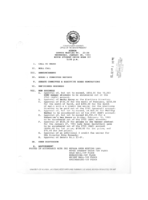Search the Special Collections and Archives Portal
Search Results

Meeting minutes for Consolidated Student Senate University of Nevada, Las Vegas, January 20, 1993
Date
1993-01-20
Archival Collection
Description
Includes meeting agenda and minutes with additional information about senate bills.
Text

Interview with Robert James Agonia, June 29, 2005
Date
2005-06-29
Archival Collection
Description
Narrator affiliation: Dept. of Energy Human Resources; Nevada Test Site Historical Foundation
Text

Interview with Helen Marguerite (Troester) Draper, June 24, 2004
Date
2004-06-24
Archival Collection
Description
Narrator affiliation: Paymaster, Reynolds Electrical and Engineering Company (REECo)
Text

Interview with Edward Bonfoy Giller, April 5, 2005
Date
2005-04-05
Archival Collection
Description
Narrator affiliation: U.S. Air Force General; Director Military Application, Atomic Energy Commission
Text

Interview with Paul Guthals, April 14, 2005
Date
2005-04-14
Archival Collection
Description
Narrator affiliation: Project leader, Nuclear Bomb Cloud Sampling, Los Alamos National Laboratory
Text

Interview with Nick C. Aquilina, June 25, 2004
Date
2004-06-25
Archival Collection
Description
Narrator affiliation: Manager, Department of Energy Nevada Operations Office (NVOO)
Text

Interview with Donald David James, July 12, 2006
Date
2006-07-12
Archival Collection
Description
Narrator affiliation: Environmental Protection Specialist, Public Health Service, Environmental Protection Agency
Text

Interview with Vernon Henry Jones, October 4, 2005
Date
2005-10-04
Archival Collection
Description
Narrator affiliation: Electrical technician, Edgerton, Germeshausen, and Grier (EG&G)
Text

Interview with Richard Vaughn Wyman, June 13, 2005
Date
2005-06-13
Archival Collection
Description
Narrator affiliation: Geologist, Asst. Manager of Operations, Reynolds Electrical and Engineering Company (REECo)
Access note: Audio temporarily sealed
Access note: Audio temporarily sealed
Text

Interview with Richard Vaughn Wyman, July 7, 2005
Date
2005-07-07
Archival Collection
Description
Narrator affiliation: Geologist, Asst. Manager of Operations, Reynolds Electrical and Engineering Company (REECo)
Text
Pagination
Refine my results
Content Type
Creator or Contributor
Subject
Archival Collection
Digital Project
Resource Type
Year
Material Type
Place
Language
Records Classification
